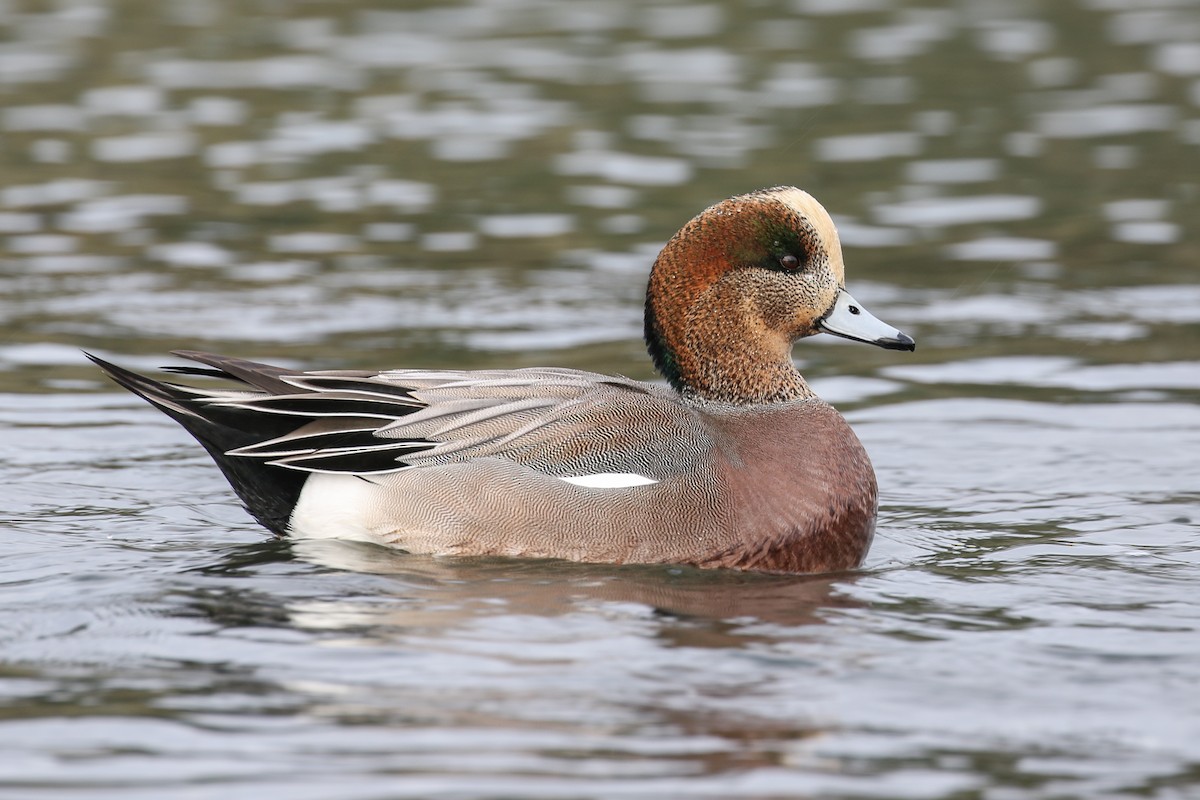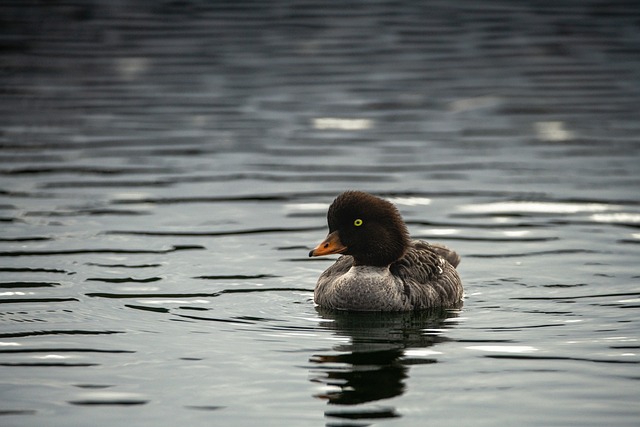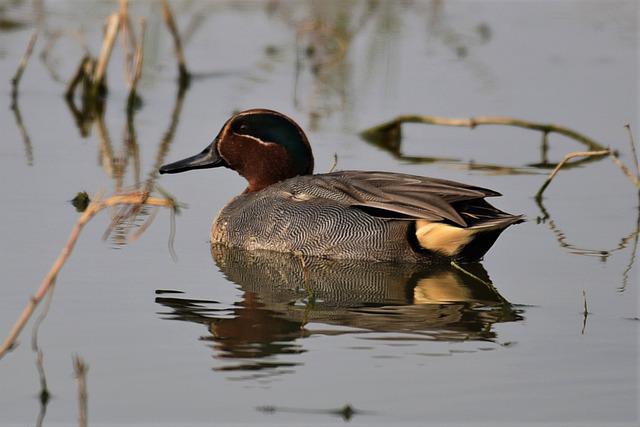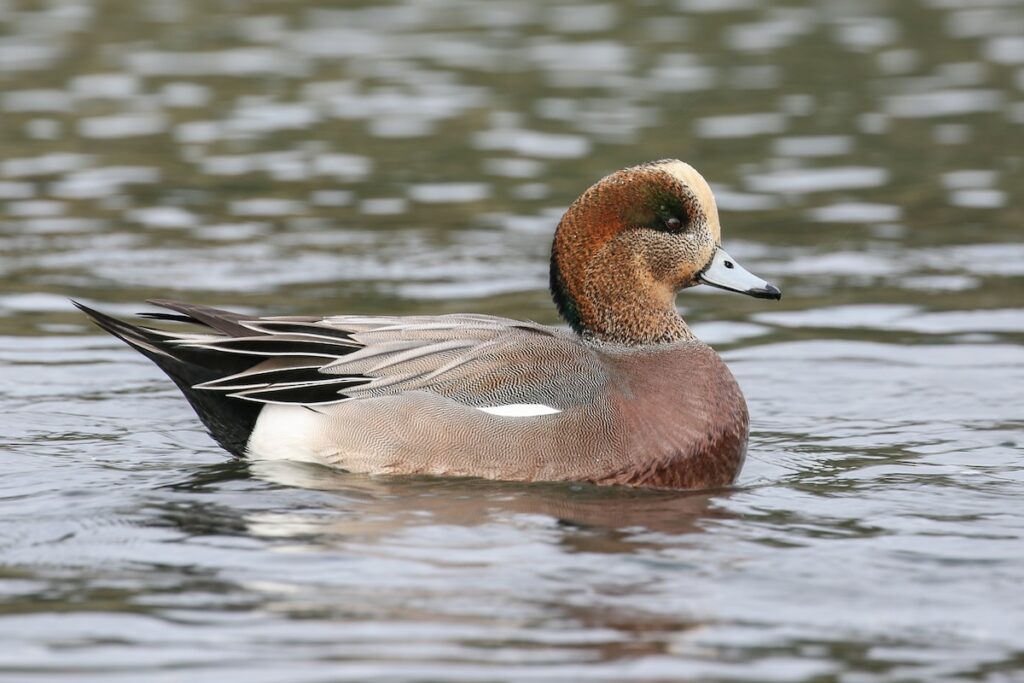Hi there! If you’re a bird enthusiast or just love the sight of colorful waterfowl, you’re in for a treat.
In this article, I’ll be sharing with you the top seven types of ducks with green heads, also known as green-headed ducks.
These stunning birds are not only beautiful to look at, but they also have fascinating behaviors and habitats.
Whether you’re interested in learning more about duck species or simply enjoying the beauty of nature, this article is sure to delight you.
So, let’s dive into the world of green-headed ducks and discover these incredible birds together.
| Image | Name |
|---|---|
 | Male American Wigeon |
 | Male Wood Duck |
 | Common Goldeneye |
 | Northern Shoveler |
 | Male Mallard Duck |
 | Green-Winged Teal |
 | Male Greater Scaup |
Types of Ducks with Green Heads
1. Male American Wigeon

The male American Wigeon, which spends most of its time during the mating season in Alaska, may be identified by the bright green stripes that run down each side of its head, as well as the gray-black speckled plumage that covers the rest of its face.
In addition to that, it has a chest that is the color of slate, a white rump, and black tips on its wings and tails.
In contrast, the female American Wigeon possesses feathers that are a uniform gray-brown color all over its body and lacks the green stripes that are seen on the male’s head.
During the mating season, American Wigeons may also be spotted across Western Canada, which is located between the Midwest and also the Rockies in the United States.
On the other hand, once autumn arrives, they will start their long journey south to the states of the southern United States, which is bordered by the Atlantic and Pacific coastlines so that they may spend the winter in milder temperatures.
In contrast to many other species of duck, the American Wigeon chooses to build its nest in dry grasslands or open fields, often quite a distance from any body of water.
Because of this, both their eggs and they’re young are kept safe from any threats, including predators as well as any rapid rise in water level.
The American Wigeon would be a dabbling duck, meaning it feeds on land as well as in the water.
It consumes plants in both environments.
It also consumes insects and worms, both those that live on land and those that live in water.
2. Male Wood Duck

The male Wood Duck possesses an emerald-green crown that is bordered by pure-white markings, and it also has a green spot over each eye, making it among the most stunning examples of a green-headed duck in entire North America.
In addition to these characteristics, it possesses a brown tail and back, iridescent brown breasts that are marked with white spots, and flashes of blue over the rest of its body.
The Pacific Coast, the Eastern United States, and sections of the Northwest are prime locations to see a Wood Duck.
They are also found in Canada.
Those Wood Ducks who chose the Canadian border as their nesting sites will go farther south during the wintertime, but the vast majority of Wood Ducks stay in the same location throughout the year.
They do both, nesting and roosting, in the hollow of trees that are located close to a water supply in forested wetlands.
Here, they also have quick access to the sources of food that they like.
Insects that live in water, fruit, and seeds all fall under this category.
When food is limited, they are not afraid to go deeper interior, where there is less competition for it.
3. Common Goldeneye

It shouldn’t come as much of a surprise where the Common Goldeneye got its name from!
Each of these ducks has brilliant yellow eyes, and there is a little white dot in the corner of each one of them.
Its whole head is also decorated in shimmering greenish plumage that provides a lovely contrast with its yellow eye.
The remainder of its body is coated in plumage that is either pristine white or jet black.
The female Common Goldeneye doesn’t have green plumage on its head but instead has feathers that are a grayish-brown color.
The Common Goldeneye is a bird that is native to North America and spends its mating season in the northern parts of Alaska and Canada before heading south for the wintertime.
They are not picky about the kind of water they live near as long they can find trees in the area that have holes in them for them to nest and roost in.
The Common Goldeneye is a species of diving duck that consumes a wide range of food, such as fish, insects, crayfish, crabs, fish eggs, and shrimp, among other things.
You may assume that the last of them is a difficult item for a duck to consume, but the Common Goldeneye possesses powerful black bills that have little trouble breaking through the stiff shell of a crab.
4. Northern Shoveler

There are a few characteristics that may be used to positively identify a male Northern Shoveler.
The first distinguishing feature is that huge black beak fashioned like a spoon.
The second distinctive feature of this creature is its glossy green head, which features great contrast with its brilliant yellow eyes.
It also possesses rust-red sides, white underparts, and black backs, as well as blue spots on each wing, in addition to this green plumage.
Females lack the green head of their male counterparts and instead have a bright scarlet beak and a blue shoulder band on their feathers.
This green-headed duck migrates north for the mating season, sometimes traveling as far as Canada.
It spends the wintertime in the southern states of the United States.
Their tendency to congregate in social flocks and to forage in areas of shallow water is constant, no matter where in the globe they are or at what point in time they are seeing it.
The Northern Shoveler builds its nest amid sparse foliage that grows low to the ground and is located quite near the water.
In this location, a breeding pair will raise their offspring until the time arrives for them to move.
In addition to that, this environment provides them with easy access to the aquatic insects and crustaceans that they consume for food.
In addition to this, they possess a peculiar mode of digestion.
The Northern Shoveler is able to stir up the muck at the bottom of the water by moving its bill in a side-to-side motion.
After that, they will swallow a sizable mouthful of the food before straining it through a comb-like protrusion known as “lamellae” that runs down the edge of their bill.
This prevents the food from passing through while allowing other things to do so.
5. Male Mallard Duck

The male Mallard duck is not only among the most widespread ducks in North America but also among the most easily identifiable ducks.
It features a huge head that is iridescent green, a beak that is brilliant yellow, and grayish wings having blue spots that are bordered by white.
In addition to that, its underparts are white, and its back is black.
Females and youngsters have mottled-brown plumage, an orange beak, and a blue speculum, and their appearance is similar to that of the adult male.
Mallards are permanent residents of the United States and may be found throughout the country at any time of the year.
However, they prefer to remain in the same location year after year.
Only those that have spent time breeding in Alaska and Canada will go farther south during the winter months.
Their natural environment is always the same: rivers, ponds, and lakes, regardless of where in the nation they reside.
Additionally, mallards are herbivorous ducks, meaning that they consume only aquatic plants and foliage for food.
They also have an exceptionally long lifespan, with some records showing that Mallards have lived for up to 27 years.
6. Green-Winged Teal

The Green-Winged Teal is among the smallest types of ducks on this list, with an average length of roughly 14 inches.
Its wingspan also falls within the lower category.
Because of its name, you might have been able to infer that this duck has a little splotch of emerald green on each of its wings.
The remainder of its body is coated in black and white plumage, and it has a green spot that goes over each eye and down the back of its rust-colored skull.
During the nesting season, Green-Winged Teals may be found across Canada, Alaska, and even certain northern states in the United States.
As soon as the temperature begins to drop, they will take to the air and fly southward, beginning in British Columbia and making their way to the southern states.
Those who make their homes in the Rocky Mountains have the option of remaining there for the whole year if the climate is suitable.
Insects and seeds make up the majority of these ducks’ diets. In addition, they construct their nests on the ground, either in the grass, other dense vegetation, or other thickets.
Because of this, they and their young are able to remain hidden and safe from potential threats.
7. Male Greater Scaup

The male Greater Scaup possesses a head that is dark green and eyes that are brilliant yellow, and it resembles the look of the Lesser Scaup quite a little.
Additionally, it possesses white wings, a black tail, and top portions that are sprinkled with gray.
In addition, the chest is black, and the bill is light blue having a black tip.
The Greater Scaup, on the other hand, has a head that is considerably more rounded than the Lesser Scaup.
This is the primary distinction between the two species.
During the winter months, the Greater Scaup may be found along the coasts of both the Atlantic and Pacific oceans.
In the spring, they go to their mating sites across Alaska and Canada, and a phenomenon called a “raft” may be seen when large numbers of them are out at sea at the same time.
The Greater Scaup builds its nest mostly on the ground using grass and down hairs.
The nest is often constructed inside a shallow depression that already exists in the ground.
They will stay here to hatch their eggs and bring up their young until the autumn when it will be time to move on to other territories.
The green-headed duck is a species of diving duck that lives at the bottom of ponds and feeds on the plants and insects that live there.
In addition to this, when they are hungry, they will plunge into the waters of the shallow sea.
Conclusion
In conclusion, the seven types of ducks with green heads that we’ve discussed in this article are just a small selection of the many beautiful waterfowl species that exist in the world.
These ducks are not only visually stunning but also have unique behaviors and habitats that make them fascinating to observe.
From the striking Mallard to the colorful Wood Duck and the exotic Greater Scaup Duck, green-headed ducks offer a variety of opportunities to appreciate the beauty of nature.
Whether you’re a birdwatching enthusiast or simply enjoy the outdoors, taking the time to observe these magnificent creatures can be a truly rewarding experience.
So, grab your binoculars and head to your nearest wetland, pond, or lake to witness the beauty of green-headed ducks for yourself.
FAQ
What are green-headed ducks?
Green-headed ducks are a group of waterfowl species that have distinctive green feathers on their heads. This coloring is caused by iridescence, a visual effect created by the reflection of light off the feathers.
What other features do green-headed ducks have besides their green heads?
Green-headed ducks come in a variety of shapes, sizes, and colors. Some species have brightly colored bills, striking plumage, or unique patterns on their wings. Many green-headed ducks also have interesting behaviors, such as courtship displays and nesting habits.
What is the habitat of green-headed ducks?
Green-headed ducks can be found in a variety of wetland habitats, including ponds, lakes, rivers, and swamps. Some species prefer freshwater habitats, while others are adapted to saltwater environments.
Are green-headed ducks common?
Many species of green-headed ducks are common and can be found in a wide range of habitats across North America, Europe, Asia, and other parts of the world. Some species, however, are rare and endangered, and their populations are declining due to habitat loss, hunting, and other factors.
What is the best way to observe green-headed ducks?
The best way to observe green-headed ducks is by visiting wetland habitats where they are known to occur. You can also observe them at wildlife refuges, parks, and other natural areas. Bringing binoculars or a spotting scope can help you get a closer look at these beautiful birds without disturbing them.
Last Updated on April 8, 2023 by Lily Aldrin
